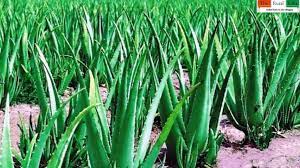New Delhi: Aloe vera or aloe vera is used in abundance in making cosmetics products. You must have seen that the aloe vera plant will be seen in a pot in the balcony of every house. It is a great face massager and is also used to make hair shine. For this reason, it also has a lot of demand in the market. In view of the increasing demand, its cultivation is proving to be a profitable deal.
Many companies also do its contract farming, if it is cultivated in a commercial way, then it can earn up to 8-10 lakh rupees annually. In this article, I will tell my farmer brothers about the cultivation of aloe vera.
Before you start farming, know what it is like. Ghrit Kumari or Aloe Vera/Aloe vera, also known as Kvaragandal, or Gwarpatha. It is famous all over the world as a medicinal plant. Aloe vera plant is a pulpy and succulent plant without stem or very short stem. Its length is up to 60-100 cm. It is spread by branches coming out from below. Its leaves are lanceolate, thick and fleshy, green, greenish-gray in color, with white spots on the upper and lower surface of the leaf in some varieties. There are small white thorns on the edges of the leaf. Yellow flowers appear in the summer season.
Years of research went on to find out the varieties of aloe vera. After this it was found that there are 300 types of aloe vera. It has 0 to 15 percent medicinal properties in 284 varieties of aloe vera. 11 types of plants are poisonous, one of the remaining 5 special types is a plant named Aloe barbadensis Miller. It has 100% medicinal and medicinal properties. And its aloe species which has beneficial medicinal and healing properties and is specially used to soothe burns. Apart from this, another variety called aloe, it is known as real pita or aloe maculata. It is used to treat all types of skin conditions.
The warm climate is considered suitable for the cultivation of aloe vera. It is generally cultivated successfully in dry area with minimum rainfall and in hot humid area. That is, it gives good yield in gray soil. In contrast, the aloe vera plant is sensitive to extreme cold conditions. Farming should not be done during this time. For this, soil or soil can be done in different types of soil from sandy to loamy soil. Sandy soil is best for this. Apart from this, it can also be cultivated in good black soil. For the cultivation of aloe vera, the ground level should be at a slight elevation and there should be proper drainage system in the field. Do not fill with water. The pH value of its soil should be 8.5.
It is advisable to plant aloe vera plants in July-August for good yield. By the way, it can be cultivated throughout the year except the winter months.
For farming, first of all the land should be plowed. About 15 to 20 tons of rotted cow dung should be applied during the last tillage to increase the fertility of the soil. The more you put it, the better the yield will be.
To prepare aloe vera seedlings, sowing should be done by 6-8 seedlings. It is sown by 3-4 months old tubers having four to five leaves. About 5000 to 10000 steps/suckers are required for one acre of land. The number of seedlings depends on the fertility of the soil and the distance from plant to plant and row to row distance.
Several varieties of aloe vera have been developed by the National Bureau of Plant Genetic Sources for aloin and gel production. CIMAP, Lucknow has also developed an improved variety (Ancha / AL-1), for commercial cultivation, farmers who have cultivated Aloe vera in the past and are treating leaves in the production of juice / gel etc., then they can use new Contact us for variety.
Khud (ridges and furrows) are made in the field for planting aloe vera. It takes two lines in one meter and then leaving one meter blank, two lines should be put in one meter again. After removing the small plants from the old plant, the ground should be pressed well around the plant, in the rainy season, some small plants start coming out from the old plants in the field. Is. While transplanting it, a distance of 40 cm should be kept on its groove and doli. Small plant should be planted at a distance of 40 cm. Its planting density should be 50 thousand per hectare and the distance should be 40 by 45 cm.
One irrigation should be done immediately after sowing. After this, irrigation should be continued as per the requirement. Periodic irrigation increases the amount of gel in the leaves. Removal of weeds is necessary i.e. weeding should be done.
According to the Indian Council for Agricultural Research (ICAR), the cost of plantation in one hectare comes to about Rs 27,500. Whereas, if we add wages, farm preparation, manure etc., then in the first year this expenditure reaches Rs 50,000.
If Aloe Vera is cultivated with good care throughout the year, then about 40 to 45 tons of thick leaves are obtained from cultivation in one hectare. Aloe or aloe vera can also be sold from these leaves. Its thick leaves cost around Rs 15,000 to 25,000 per tonne in different mandis of the country. Accordingly, if you sell your crop, you can easily earn 8 to 10 lakh rupees.
 Indian Thought Latest News & Views
Indian Thought Latest News & Views



